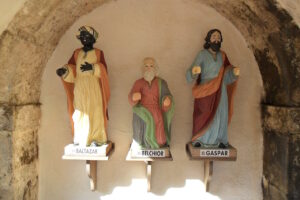2 Kings 4: 42-44; Psalm 145; Ephesians 4: 1-6 (RM) or 3: 14-21 (RCL); John 6: 1-15 (RM) or 1-21 (RCL).
Oh I remember this one. For some odd reason it stuck in my memory from sometime in childhood.
The story as I remember it begins with the boy’s mother cheerfully packing his lunch with the five barley loaves and two fish to send him off to hear Jesus. She may have warned him to be home by dark. Clearly she was not a helicopter parent, or afraid that he would be abducted, or worse. This was a different time and culture, characterized by extended families. We caught a hint of that in Luke’s story of the twelve-year-old Jesus staying behind in the Temple – Mary and Joseph just assumed he was with family and friends in the entourage, and didn’t worry about him right away.
It’s a Bible story that’s easy to retell in a way that supports children’s sense that Jesus loves them, and that they can contribute something that really matters.
Barley loaves were the food of the poor. Barley was coarse, hard to digest and not very tasty, but very basic. As children we wouldn’t have seen that in the story. We were probably thinking of peanut butter and jelly, or perhaps bologna or tunafish … or maybe lobster scraps if you grew up on the coast of Atlantic Canada.
The nameless boy has a non-speaking role in this story. We might safely assume that Philip asked him to contribute his lunch, and the boy cooperated, or even that he volunteered to share. A child’s generosity is integrated into the story.
In the children’s version this story’s high point is a gee-whiz-wow miracle story: Just two fish and five barley loaves, and look at the ton of food left over! How did Jesus do it? Jesus is “the Prophet,” the super-hero. Jesus saves the day.
And then we grew up. We learned to see different levels in a story, levels of symbolism or analogy, images that pointed to something besides themselves. So what do we do with this story now?
Well, some pastors and priests are still preaching gee-whiz-wow. They point to what the story tells about Jesus as a prophet who can work feeding miracles, like Elisha. John’s Jesus elsewhere describes himself as “the true manna come down from heaven,” setting up a parallel with the Hebrew Bible and the Exodus event.
Theologian Rosemary Radford Ruether did something completely different. She proposed that what really happened was that the example of the boy who shared his simple lunch inspired all of the other thousands of people to bring out the food they’d packed for the day as well, and share it. As a result there were more leftovers than anyone could have imagined.
Ruether’s account makes perfect sense. It appeals to us as sensible, practical adults. But something may have been lost here, and it’s not just the magical gee-whiz-wow. It’s what we might call the depth dimension, or better, the infinity dimension. This story should astonish us with God’s lavish generosity, stretching our imagination, expanding the scope of our faith to larger than life size.
We don’t know exactly what happened at the event that inspired this account. The writers of John do not call this a miracle, but instead a sign. In fact the whole first part of John has been called “the Book of Signs.” Signs of the power of Jesus as a prophet, in a long line of patriarchal prophets who showed signs of great power.
But in daily life under conditions of scarcity, who is it who stretches meagre food resources to feed a family, or a crowd for that matter? Who learns how to make food scraps and offal tasty, or at least bearable? Who goes out in search of wild greens and edible berries to augment the vitamin content? Who will be most likely to sacrifice their own meal in order to feed the children? Right.
We don’t have to squint too hard to see a classic gender divide here. And at the same time, we can marvel at divine generosity, poured out through the hands and the ingenuity of human caregivers, love incarnate, then and now. And give thanks.
© Susan K. Roll
This Reflection has been substantially revised from that of July 25, 2021.
Susan Roll retired from the Faculty of Theology at Saint Paul University, Ottawa, in 2018, where she served as Director of the Sophia Research Centre. Her research and publications are centred in the fields of liturgy, sacraments, and feminist theology. She holds a Ph.D. from the Catholic University of Leuven (Louvain), Belgium, and has been involved with international academic societies in liturgy and theology, as well as university chaplaincy, Indigenous ministry and church reform projects.





First of all, I love the photo accompanying this reflection. I have spent a lot of time with that child by the water.
Secondly, thank you for leading us beyond the “gee-whiz-wow” dimension of this story, and astonishing us “with God’s lavish generosity, stretching our imagination, expanding the scope of our faith to larger than life size.”